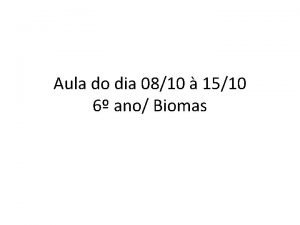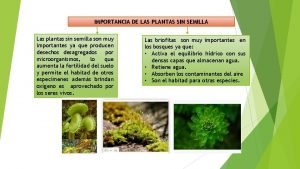LAND USE AND LAND COVER CHANGE IN AMAZONIA

- Slides: 1

LAND USE AND LAND COVER CHANGE IN AMAZONIA FRONTIER, JI -PARANÁ BASIN – RONDÔNIA Laís de Carvalho Hanadaa; Maria Victória Ramos Ballestera; Reynaldo Luiz Victóriaa & Jeffrey Edward Richeyb a Centro de Energia Nuclear na Agricultura/ USP (CENA/USP) (lchanada@esalq. usp. br); b School of Oceanography-University of Washington, USA Introduction A massive land use change has occurred in the Amazon basin in the last 3 decades, resulting from a complex product of economic and social factors, infrastructure development, soil characteristics and cultural factors that are reflected in the deforestation process. The Ji-Paraná basin is located in the State of Rondônia and comprises an area of 75, 400 km 2, encompassing 31% of the State. Most of the colonization projects accurred here. Today, more than 60% of the state population lives in the Ji-Paraná basin. Objects Results The main objective of this study is to better understand the land use and cover Our results show that the basin lost 20% (15, 313 km 2) of the original forest cover changes in Ji-Paraná basin in the last 15 years and to analyze some drives of (without savanna class) in 15 years. In 2001 the forest class represented 41, 100 km 2 tropical deforestation like soil fertility, roads distance and settlements. (55%) of the basin area. The results also indicate that regrowth areas are reuse, Study area mainly in 1996 to 2001 period. Methods The overall accuracy of the six classes 1º STAGE was 86, 34% with a kappa of 0, 73. Topografic maps Landsat-7/ETM+ Scenes (1999) IBGE 8 Scenes Data Acquisition 1986, 1992, 1996 e 2001 Geometric Rectification Landsat-7/ETM+ Scenes (1999) Landsat-7 e Landsat-5 Scenes The larger forest patches are located in flat, poor fertile (base saturation lower than Registration (1986, 1992, 1996 e 2001) 50%) and scarce road area, corresponding to 17. 563 km 2 (23, 30%), where 5056 km 2 (6, 7%) are located in conservation units. The forest patches on rich soils are located Geometric Rectification at the central part of Ji-Paraná basin (5, 500 km 2) and in areas with scarce roads and Landsat-7 e Landsat-5 Images near conservation units (6550 km 2). (1986, 1992, 1996 e 2001) Registration Agricultural areas comprise only 732 km 2 (1%) located in distrofic soil with scarce roads and 1481 km 2 (2%) in distroc soil and near the main roads. Digital Classification Supervised Classification (Maxver) Scenes (1986, 1992, 1996 e 2001) Classified Mask: 3 x 3 window Mosaics Scenes Reference points GPS 1986 Accuracy Assessment Thematic Maps 1992 1996 2001 Software: ERDAS_IMAGINE 8. 5 2º STAGE BASE SATURATION MAP Geostatistical Analyst Multiple Regression: Distance to the main road and Soil fertility are signifivative SIGTERON Data Arc-GIS 8. 1 respectively (Software: STATISTICA) Reclassification Conclusions BASE SATURATION MAP The Amazon basin has a big extension, almost 7 million km 2. It has distinct land 1 - Distrofic soils (V% < 50%) 2 - Eutrofic soils (V% > 50%) Fertility soil x Road distance characteristics (soil quality, topography), economic, social. Examination of land 1 - 1/1 Cross Tabulation 2 - 1/2 Fertility soil x Road 3 - 2/1 distance x Land Use 4 - 2/2 change -2001 1 - 1/1 ROADS MAP (BUFFER - 15 km around main roads) 1 - untill 15 km to main roads 2 - far away to main roads influences to deforestation processes in all data studied (p<0, 0002) and (p<0, 8 10 -20), Cross Tabulation 2 - 1/2 3 - 1/3 cover changes leads to a more comprehensive understanding of ecological processes and can be used in land use planning. Our results show the influence of soil fertility and road distance can be used to explain the deforestation process in Ji-Paraná basin. 4 - 1/4 Land Use and Cover Change (2001) 5 - 1/5 1 - Forest; 2 - Agricultural area; 3 - Savana; 4 - Urban area; 5 Regrowth other 6 - 2/1 Support:

